DESIGN FOR THE CASE OF ASYMMETRIC REFLECTION
For reflection that is not normal (i.e., an offset feed to reduce feed antenna blockage), a modified phase distribution is required (see Figure 8a). The angle of reflection is set to θ = 15 degrees from normal incidence and the required phase distribution is remapped (see Figure 8b). The number of cells remains the same as for normal reflection.
Results of the simulation (see Figure 8c) show that the reflectarray creates a far-field beam inclined to θ = 15 degrees as expected. Simulated azimuthal radiation patterns are plotted in Figure 8d over frequency and they share similar characteristics.
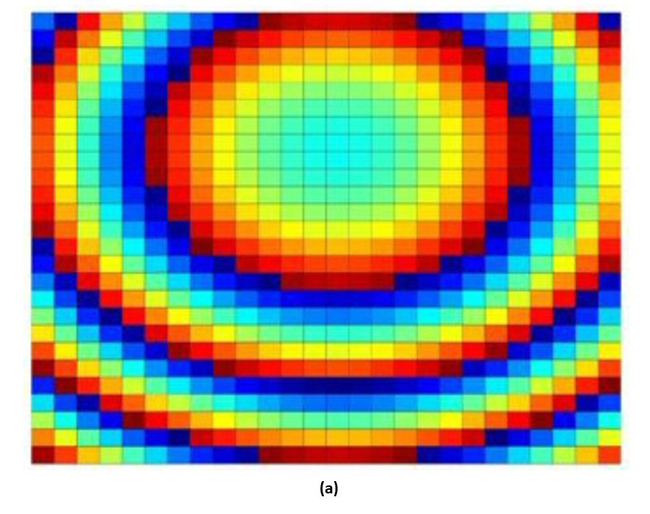
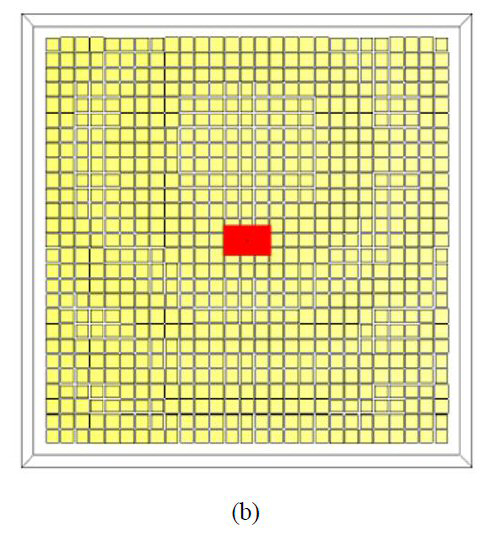
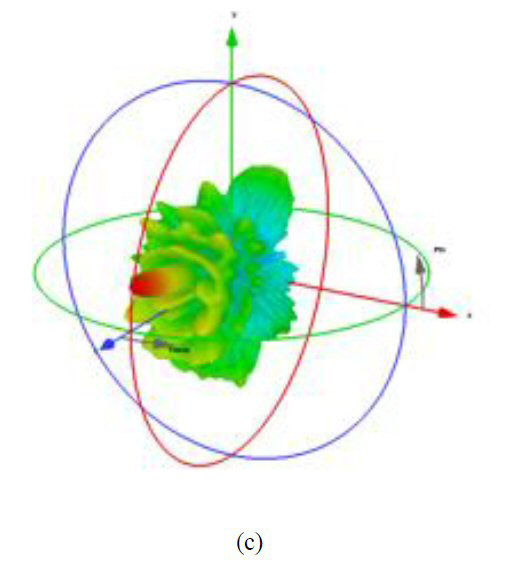
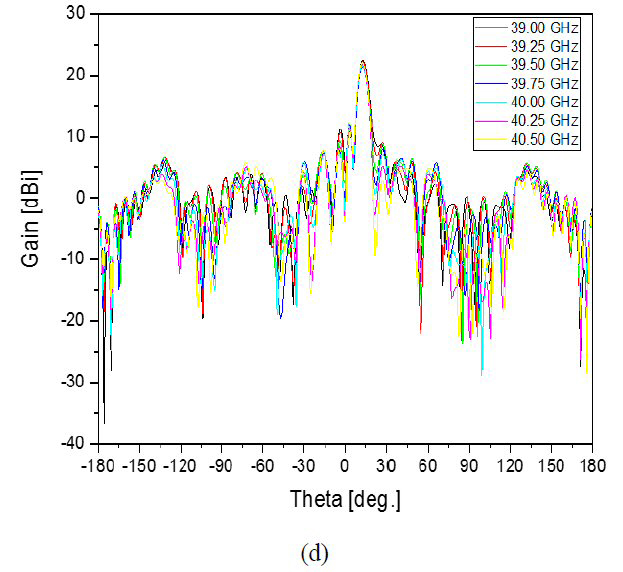
Figure 8 The 1-bit reflectarray for asymmetric reflection: required phase distribution (a), top view (b), simulated 3D radiation pattern (c) and simulated far-field azimuth radiation patterns over frequency (d).
Assembly and Measurement
Figure 9a shows the reflectarray designed for a 15-degree offset feed. |S11| at the input of the horn is shown in Figure 9b as measured in an anechoic chamber (see Figure 9c). Differences between measured and simulated |S11| are attributed to imperfect mechanical alignment and mounting.
In Figure 9d the beam is tilted to the desired angle of reflection, but there is a drop in antenna gain of up to 2.5 dB and deterioration in sidelobe level of about 3 dB. This is attributed to the measurement setup and instrumentation as well as simplifications in the design to limit the number of bits in the phase distribution.
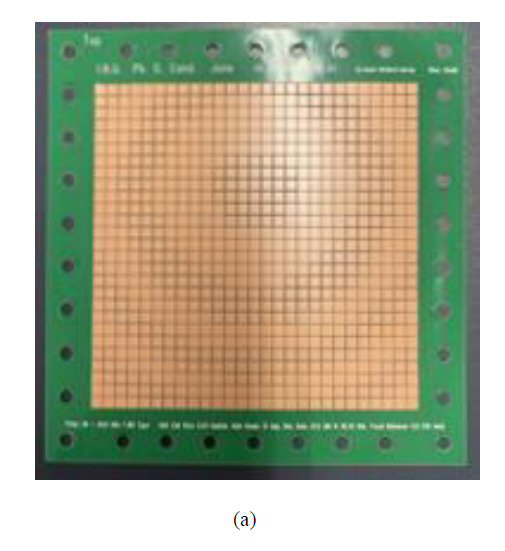

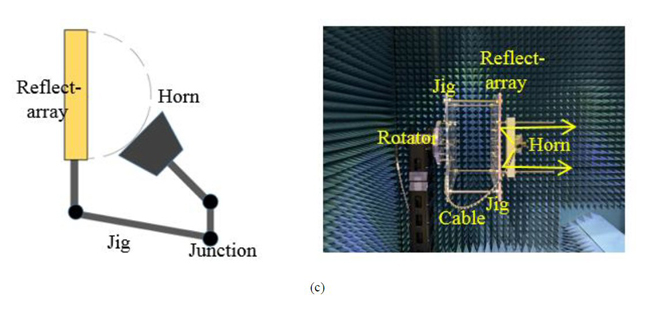
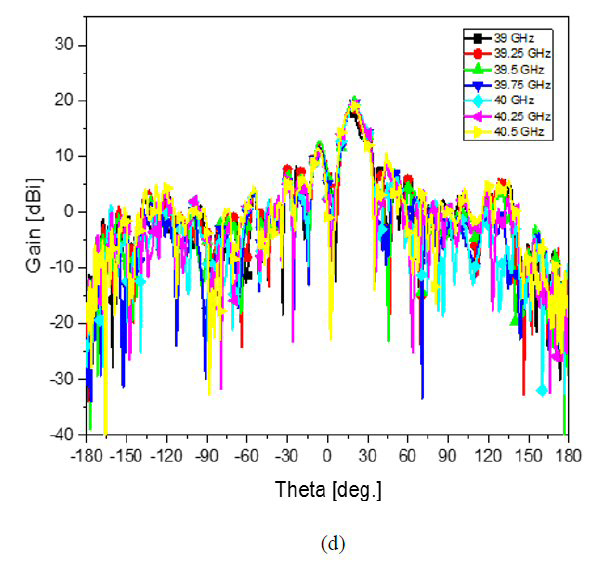
Figure 9 Prototype of the 1-bit reflectarray with an offset feed: reflecting surface (a), measured versus simulated |S11| (b), test setup (c) and measured far-field azimuth radiation patterns over frequency (d).
CONCLUSIONS
A single-layered Q-Band reflectarray antenna is designed with a 1-bit phase distribution for the metallization pattern on a conventional dielectric substrate. Using inexpensive fabrication methods, a discrete phase distribution for normal and asymmetric reflection is realized in the design of the reflecting surface. The less than 10 × 10 cm reflectarray demonstrates greater than 20 dBi gain. Measured EM characteristics agree well with the simulation. The design is believed to be well-suited for use in mmWave airborne wireless communication and sensing systems.
ACKNOWLEDGMENT
This work was supported by the Technology Innovation Program (Project Code: 20016463) funded By the Ministry of Trade, Industry & Energy (MOTIE, Korea).
References
- Y. Kim, H. -Y. Lee, P. Hwang, R. K. Patro, J. Lee, W. Roh and K. Cheun, “Feasibility of Mobile Cellular Communications at Millimeter Wave Frequency,” IEEE Journal of Selected Topics in Signal Processing, Vol. 10, No. 3, April 2016, pp. 589-599.
- M. Shafi, A. F. Molisch, P. J. Smith, T. Haustein and P. Zhu, “5G: A Tutorial Overview of Standards, Trials, Challenges, Deployment and Practice,” IEEE Journal on Selected Areas in Communications, Vol. 35, No. 6, June 2017, pp. 1201-1221.
- “NTN & Satellite in Rel-17 & 18,” The 5G Standard, News & Events Partner News, July 2022.
- “Enterprise-Grade 5G for Business of all Sizes,” AT&T Business, September 2016.
- “How an Automated Car Platoon Works,” Volpe Center U.S. Department of Transportation, July 2017.
- “Package Delivery by Drone (Part 135),” U.S. Department of Transportation, July 2022.
- J. D. Kraus and R. J. Marhefka, Antennas for all Applications, McGraw-Hill, 2002.
- S. Abulgasem, F. Tubbal, R. Raad, P.I. Theoharis, S. Lu and S. Iranmanesh, “Antenna Designs for CubeSats: A Review,” IEEE Access, Vol. 9, March 2021, pp. 45289-45324.
- E. Martinez-de-Rioja, D. Martinez-de-Rioja, R. López-Sáez, I. Linares and J. A. Encinar, “High-Efficiency Polarizer Reflectarray Antennas for Data Transmission Links from a CubeSat,” Electronics, Vol. 10, No. 15, July 2021.
- H. Yamani and J. Yoon, “Isolation Improvement in Reflectarray Antenna-Based FMCW Radar Systems,” Sensors, Vol. 22, No. 22, 2022, November 22.
- J. Zhao, H. Li, X. Yang, W. Mao, B. Hu, T. Li, H. Wang, Y. Zhou and Qiao Liu, “A Compact Ka-Band Monopulse Cassegrain Antenna Based on Reflectarray Elements,” IEEE Antennas And Wireless Propagation Letters, Vol. 17, No. 2, February 2018, pp.193-196.
- M. K. T. Al-Nuaimi and W. Hong, “Discrete Dielectric Reflectarray and Lens for E-Band With Different Feed,” IEEE Antennas And Wireless Propagation Letters, Vol. 13, No. 5, May 2014, pp. 947-950.
- Z. -W. Miao, Z. -C. Hao, Y. Wang, B. -B. Jin, J. -B. Wu and W. Hong, “A 400-GHz High-Gain Quartz-Based Single Layered Folded Reflectarray Antenna for Terahertz Applications,” IEEE Transactions on Terahertz Science and Technology, Vol. 9, No. 1, January 2019, pp.78-88.
- Anokiwave Inc., “28 GHz Active Array Antenna Enables Rapid 5G Prototyping,” Microwave Journal, Vol. 60, No. 4, April 2017, pp. 38-44. 15.D. K. Cheng, Field and Wave Electromagnetics, Addison-Wesley, USA, 1989.
- D. K. Cheng, Field and Wave Electromagnetics, Addison-Wesley, USA, 1989.

